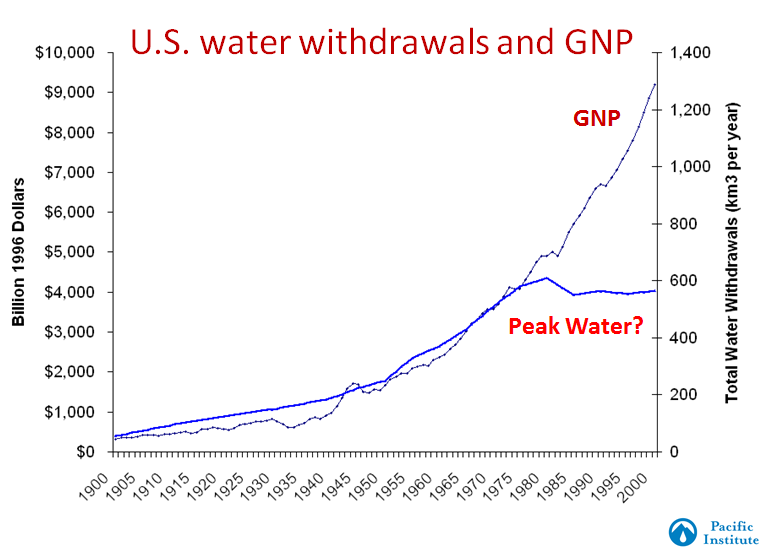Some thoughts for today: the bad news and good news for World Water Day. [First, I think every day should be World Water Day, not just March 22nd, but hey, that’s just me.]
- Stop taking your tap water for granted. Go to your tap, draw a glass of water, and drink it. Then remember that nearly a billion people still do not have reliable access to safe, affordable tap water and cannot do what you've just done.
- Stop taking your toilet for granted. Nearly 2.5 billion people (more people than lived on the planet in the 1930s) don’t have safe sanitation.
- Do you know anyone who had cholera, or typhoid, or dysentery? Most likely not. Yet just a few generations ago, some of your ancestors certainly died from one of these diseases – associated with the lack of safe water and sanitation.
- That food you’re eating? It took a lot of water to produce it. Around 80 percent of all of the freshwater humans use goes to grow food. The rest is split among home, industrial, and commercial uses.
- Those clothes you’re wearing? It took a lot of water to produce them as well, whether you’re wearing cotton or polyester. A cotton t-shirt involves cotton that may be grown in India, woven into fabric and dyed in China, finished in Mexico, and sold in the U.S. Thus the “water footprint” of that shirt could involve water from around the world. [Here is a report we just released on California’s water footprint; and here is a more general link to water footprints at the Water Footprint Network.]
- Turn on your computer or light? It took water – yes, water – to produce that energy. Depending on the energy source, it might have taken a lot of water. But renewable energy sources typically (not always) require far less water for every kilowatt-hour of energy produced.
- We read all the time about the damages we’re doing to the environment, and especially, the species of that we’re driving to extinction. But most of them aren’t furry mammals or photogenic megafauna. The majority of species threatened with extinction are aquatic – threatened by human use and contamination of water. More than one-third of threatened and endangered species in the U.S. live only in wetlands, according to the U.S. EPA.
- Violent conflicts happen for many reasons: economic, religious, ideological, geographical, ethnic, and more. But a growing number of conflicts are linked to disputes over water resources. (You can find a comprehensive list at The Water Conflict Chronology that is maintained by the Pacific Institute.)
- “There is compelling, comprehensive, and consistent objective evidence that humans are changing the climate in ways that threaten our societies and the ecosystems on which we depend.” Among other things, this evidence includes rapidly rising temperatures, dramatic losses of the Arctic ice cap, disappearing glaciers, ocean acidification, ecosystem shifts, and rising seas. Some of the most severe impacts of climate changes will be on water resources – both supply and demand.
- Because climate changes are already occurring, weather events, including extreme events, are increasingly influenced by them. Scientists have been clear: expect to see more extremes of heat, extended drought, and water shortages in many places. This year, keep a concerned eye on the water situation in the central and southwestern United States.
Some Good News
- The assumption that demand for water must go up, up, up with population and economic growth is wrong. The U.S. (and many other countries) uses less water today than 35 years ago and far less per person. This is due to a combination of improved efficiency and changes in our economy. Figure 1 shows this trend for the U.S., and it is great news.
 Total U.S. water withdrawals peaked and then declined after the late 1970s, even while population and GNP have continued growing. Source: Gleick 2003 Annual Reviews.
Total U.S. water withdrawals peaked and then declined after the late 1970s, even while population and GNP have continued growing. Source: Gleick 2003 Annual Reviews.
- There is tremendous additional potential for improving efficiency and productivity of water use. We can do far more with less water in every sector from agriculture to industry to our homes.
- It is possible to restore damaged natural ecosystems if we restore some semblance of natural water stocks and flows. Removing hundreds of old, unsafe, harmful dams has led to improved safety, restored fisheries, and healthier ecosystems. In 2012, 62 dams were removed in the United States alone.
- There is a formal “human right to water” declared by the United Nations General Assembly and Human Rights Council, and while by itself this will not magically solve water problems, it acknowledges the importance of meeting basic needs and lays out the responsibilities of nations to more actively address water and sanitation needs for their poorest populations.
- There are wonderful non-governmental, international, and community organizations of all kinds working on water problems, from research (such as my own Pacific Institute) to on-the-ground assistance. (Here is one list; here is another; commenters should feel free to add more!).
So happy World Water Day. Don’t take your water for granted – and take action.
- Log in to post comments
More like this
My new Science Magazine article “Water Strategies for the Next Administration” has just been released (embargo lifts 11am Pacific, November 3rd; the print version will appear in the November 4th issue of Science). It identifies six major water-related challenges facing the United States and offers…
By Peter Gleick (Pacific Institute) and Carl Ganter (Circle of Blue)
1. The California Drought Becomes an Emergency
California’s multi-year drought grew dire enough in 2014 to prompt Governor Jerry Brown to declare a drought emergency in January. By the end of the year, California had experienced…
The numbers are in for 2012, and they are shocking. The Beverage Marketing Corporation, which tracks sales and consumption of beverages, is reporting that sales of bottled water grew nearly 7 percent between 2011 and 2012, with consumption reaching a staggering 30.8 gallons per person. And since I…
Today is World Water Day, and this year's theme is "Water and Food Security." UN Water explains why we should care:
Each of us needs to drink 2 to 4 litres of water every day. But it takes 2 000 to 5 000 litres of water to produce one person's daily food.
Today, there are over 7 billion people to…

I worked the canadian water network conference in ottawa this past week. one of the curious things that seemed to be the norm at these things is that the crowd had water on their minds 24/7 and were very nice 24/7. I felt like a meanie asking even the softest questions of the panelists. Do you find this
to be the case at mumbai? i would like your take on this phenom peter. as always great work.
bob brouse
water.ca
The entire Owens Vally in California had all its water stolen by the Los Angeles Department of Water and Power 80 years ago - so folks could water their lawns, take 15 minute showers and fill their pools.
Just freakin' wonderful.